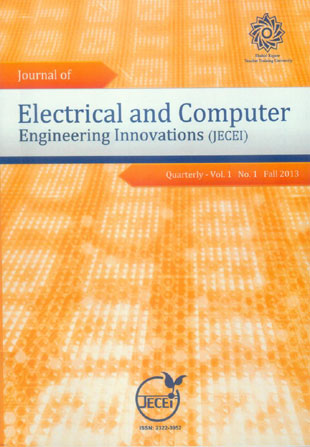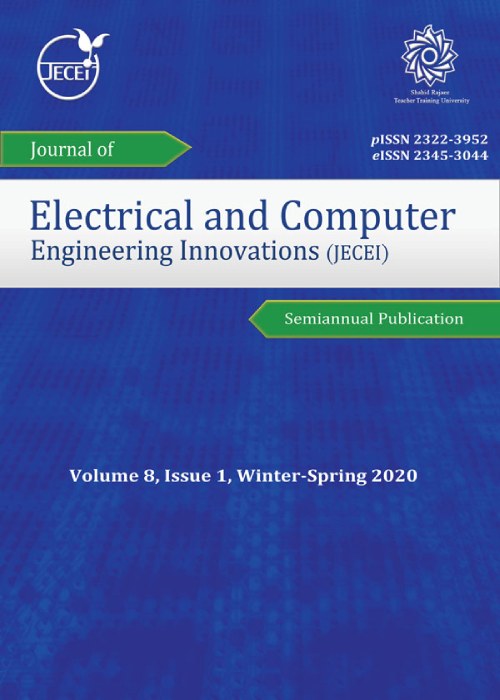فهرست مطالب

Journal of Electrical and Computer Engineering Innovations
Volume:1 Issue: 1, Winter - Spring 2013
- 66 صفحه،
- تاریخ انتشار: 1392/07/23
- تعداد عناوین: 7
-
-
Page 1For an indoor non-directed line of sight optical wireless communication (NLOS-OWC) system we investigate the optimized Lambertian order (OLO) of light-emitting diodes (LEDs). We firstly derive an expression for the OLO from a conventional Lambertian LED model. Then, we analyze the indoor multi-cell NLOS-OWC channel characteristics including the optical power distribution and the multipath time dispersion for two cases of one-cell and four-cell configurations. Furthermore, we estimate the transmission bandwidth by simulating the channel frequency response. Numerical results presented show that, by using OLO a significant improvement of the transmission bandwidth can be achieved for an indoor NLOS-OWC system, in particular, for multi-cell configurations.Keywords: Optimum Lambertian order, LED, optical wireless communication, root mean square (RMS), delay spread
-
Page 11Gesture and motion recognition are needed for a variety of applications. The use of human hand motions as a natural interface tool has motivated researchers to conduct research in the modeling, analysis and recognition of various hand movements. In particular, human-computer intelligent interaction has been a focus of research in vision-based gesture recognition. In this work, we introduce a 3-D hand model recognition method that offers flexible and elaborate representation of hand motion. We used landmark points on the tips and joints of the fingers and calculated the 3-D coordinates of these points through a stereo vision system followed by a Hidden Markov Model (HMM) to recognize hand motions. Experimentally, in an effort to evaluate the formation of hand gestures similar to those used in rehabilitation sessions, we studied three evolving motions. Given the natural hand features and uncontrolled environment, we were able to classify and differentiate unnatural slowness or rapidness in the performance of such motions, ranging from 45% to 93%.Keywords: Stereo vision, Motion evaluation, HMM.
-
Page 19In this paper, a high speed delay-locked loop (DLL) architecture is presented which can be employed in high frequency applications. In order to design the new architecture, a new mixed structure is presented for phase detector (PD) and charge pump (CP) which can be triggered by double edges of the input signals. In addition, the blind zone is removed due to the elimination of reset signal. Therefore, operating frequency of the whole system is improved which can be mentioned as notable advantage of the proposed DLL. To obtain more accurate phases at the output signal, a new delay cell is introduced which is controlled by a single voltage. This control voltage, through equalizing the rise and fall time, regulate duty cycle of output clock. These features along with simplicity and low power consumption qualify the proposed architecture to be widely used in high speed systems. For better realization of the designed circuit’s behavior, simulation results are presented based on TSMC 0.35µm CMOS technology and 3.3-V power supply for a type II filter which demonstrate accuracy and perfect performance of this work.Keywords: Index Terms— delay locked loop (DLL), phase detector (PD), charge pump (CP), filter, CMOS.
-
Page 29In this paper two different rateless transmission schemes are developed. In the proposed scheme, relay node can decode and forward the message to the destination if they are able to decode it, or amplify and forward the message to the destination. Based on the analysis and simulation results provided in this paper, the proposed method has better transmission time than the scheme which only the relay nodes that have already decoded the message participate in the second phase. Due to the simplicity of the amplify and forward transmission, adding this feature to the network can result in better performance without any additional complexity.Keywords: Relay networks, decode, forward strategy, rateless codes
-
Page 35In front wheels driven vehicles, fuel economy can be obtained by summing torques applied to rear wheels. On the other hand, unequal torques applied to rear wheels provides enhanced safety. In this paper, a model with seven degrees of freedom is considered for the vehicle body. Thereafter, power-train subsystems are modeled. Considering an electrical machine on each rear wheel, a fuzzy controller is designed for each driving, braking, and stability conditions. Another fuzzy controller recognizes the vehicle requirements between the driving/regeneration and stability modes. The simulations performed in MATLAB/Simulink environment show that the proposed structure can effectively enhance vehicle performance in different modes.Keywords: Fuzzy Controller, Hybrid Vehicle, Yaw Rate, Rol, l Pitch, µ, Split Road
-
Page 43If both Reference Station (RS) and navigational device in Differential Global Positioning System (DGPS) receive signals from the same satellite, RS Position Components Error (RPCE) can be used to compensate for navigational device error. This research used hybrid method for RPCE prediction which was collected by a low-cost GPS receiver. It is a combination of Genetic Algorithm (GA) computing and Artificial Neural Network (ANN). GA was used for weight optimization and RS and Mobile Station (MS) were implemented by the software. The experimental results demonstrated which GA-ANN had great approximation ability and suitability in prediction; GA-ANNs prediction' RMS errors were less than 0.12 m. The simulation results with real data showed that position component's RMS errors in MS were less than 0.51 m after RPCE prediction.Keywords: DGPS, ANN, RPCE Prediction, GA
-
Page 51In this paper, an optimal control of quadratic performance index with nonlinear constrained is presented. The sine-cosine wavelet operational matrix of integration and product matrix are introduced and applied to reduce nonlinear differential equations to the nonlinear algebraic equations. Then, the Newton-Raphson method is used for solving these sets of algebraic equations. To present ability of the proposed method, two classes, first order system and second order system, are considered. The obtained results show that the proposed method offers improved performance.Keywords: Sine, Cosine Wavelet, Optimal Control, Non, linear Systems, Constrained problems


